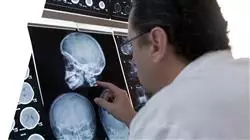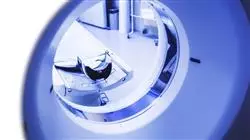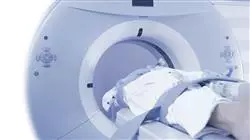University certificate
The world's largest faculty of medicine”
Description
You will perform the most accurate and thorough Forensic Diagnostics to determine the nature of deaths thanks to this 100% online Postgraduate diploma"

The advent of Industry 4.0 has had a significant impact on the medical field, completely revolutionizing the way in which forensic findings are analyzed. An example of this is provided by cutting-edge technologies such as X-Ray Imaging Systems, Magnetic Resonance Imaging or Computed Tomography. Precisely, the latter is one of the latest trends in the healthcare field due to its ability to provide higher resolution and higher quality images with faster scanning times. Additionally, this instrument is highly beneficial for detecting traumatic injuries in skeletal remains that are incomplete or in a poor state of preservation. In this way, it makes a significant contribution to experts in locating distinctive anatomical features that serve to determine the identity of individuals.
In this context, TECH is developing a revolutionary Postgraduate diploma in Forensic Diagnostic Imaging Tools of Human Skeleton. Its objective is to provide specialists with the most advanced skills to effectively handle the most sophisticated machinery and thus optimize their processes of interpretation of autopsy snapshots. For this purpose, the syllabus will delve into the use of radiology equipment such as Ultrasound, X-Ray Tube and Conventional Radiographs. Likewise, the syllabus will highlight the importance of Dosimetric Magnitudes to obtain quantitative information on radiation exposure and help in the evaluation of lesions. The specialization will also delve into the anatomical characteristics of the human skeleton, allowing graduates to adapt image analysis techniques to compare bone pathologies and morphoanatomical variations.
In order to consolidate these contents in an optimal way, TECH uses the innovative teaching system of Relearning. This is based on the progressive and natural reiteration of key knowledge, so students will enjoy effective learning without the need to memorize. The only thing they will need is a device with Internet access to access the Virtual Campus.
Are you looking for a university program that will provide you with the latest advances in Maxillofacial Forensic Radiology? Achieve it with this exclusive specialization"
This Postgraduate diploma in Forensic Diagnostic Imaging Tools of Human Skeleton contains the most complete and up-to-date scientific program on the market. The most important features include:
- The development of practical cases presented by experts in Forensic Radiology
- The graphic, schematic and eminently practical contents with which it is conceived gather scientific and practical information on those disciplines that are indispensable for professional practice
- Practical exercises where self-assessment can be used to improve learning
- Its special emphasis on innovative methodologies
- Theoretical lessons, questions to the expert, debate forums on controversial topics, and individual reflection assignments
- Content that is accessible from any fixed or portable device with an Internet connection
You will delve into the most common bone injuries among children and adolescents, to differentiate between accidental injuries and injuries resulting from aggressions"
The program’s teaching staff includes professionals from the field who contribute their work experience to this educational program, as well as renowned specialists from leading societies and prestigious universities.
The multimedia content, developed with the latest educational technology, will provide the professional with situated and contextual learning, i.e., a simulated environment that will provide immersive education programmed to learn in real situations.
This program is designed around Problem-Based Learning, whereby the professional must try to solve the different professional practice situations that arise during the course. For this purpose, students will be assisted by an innovative interactive video system created by renowned and experienced experts.
You will have at your disposal the latest scientific evidence on bone changes resulting from hormonal action, mature bone cells and the membranous ossification pathway"

The revolutionary Relearning methodology, characteristic of TECH, will allow you to consolidate complex concepts with efficiency and immediacy"
Syllabus
From a theoretical-practical perspective, this academic itinerary will provide specialists with the most innovative diagnostic imaging techniques within the forensic legal field. To this end, the didactic materials will deepen in the recognition of injuries, fractures, dislocations and pathologies. At the same time, the syllabus will provide graduates with the keys to effectively handle sophisticated tools for human identification. Among them, Computed Tomography, Magnetic Resonance Imaging and Ultrasound. In this sense, experts will enhance their skills to work closely with other professionals to determine the nature of death and present scientific evidence in complex cases.

You will acquire skills to identify bone and dental trauma based on the type of element causing the damage, including sharp-edged weapons"
Module 1. Diagnostic Imaging Techniques and Tools in the Forensic Context
1.1. Radiological Physics and its Application in the Forensic Context
1.1.1. Physics Applied to Forensic Radiology
1.1.2. Radiological Characterization in the Forensic Context
1.1.3. Structure of Matter
1.2. Operation of Equipment in the Forensic Context
1.2.1. X-ray Imaging System
1.2.2. X-ray Tube
1.2.3. Diagnostic Ultrasound
1.3. Forensic Use of Radiology
1.3.1. Computed Tomography (CT)
1.3.2. Conventional X-rays (RX)
1.3.3. Ultrasound (UI)
1.3.4. Magnetic Resonance
1.4. Forensic Radiobiology
1.4.1. Human Biology
1.4.2. Radiobiology
1.4.3. Molecular and Cellular Radiobiology
1.5. Dosimetric Quantities in Forensic Contexts
1.5.1. Radiation Protection
1.5.2. Ionization
1.5.3. Arousal
1.5.4. Fluorescence
1.6. Digital Imaging in Forensics
1.6.1. The Digital Image
1.6.2. Visualization and Understanding of Images in the Forensic Field
1.6.3. Artefacts
1.7. Forensic Computed Tomography
1.7.1. Operation
1.7.2. Scope
1.7.3. Terminology
1.8. Conventional Forensic Radiobiology Equipment
1.8.1. Operation
1.8.2. Scope
1.8.3. Terminology
1.9. Ultrasound in Forensic Medicine
1.9.1. Operation
1.9.2. Scope
1.9.3. Terminology
1.10. Magnetic Resonance in Expert Investigation
1.10.1. Operation
1.10.2. Scope
1.10.3. Terminology
Module 2. Forensic Radiology of the Non-Pathological and Non-Traumatic Human Skeleton
2.1. Forensic Radiology of the Locomotor System
2.1.1. Muscular System
2.1.2. Articular System
2.1.3. Skeletal System
2.2. Forensic Radiology of the Human Skeleton
2.2.1. Axial Skeleton
2.2.2. Appendicular Skeleton
2.2.3. Upper and Lower Extremities
2.3. Anatomical Plans and Axes of Movement in Forensic Investigation
2.3.1. Coronal Plan
2.3.2. Sagittal Plan
2.3.3. Transverse Plan
2.3.4. Bone Classification
2.4. Forensic Radiology of the Human Skull
2.4.1. Facial Bones
2.4.2. Neurocranium
2.4.3. Associated Pathologies
2.5. Forensic Radiology of the Spine
2.5.1. Cervical Vertebrae
2.5.2. Thoracic Vertebrae
2.5.3. Lumbar Vertebrae
2.5.4. Sacral Vertebrae
2.5.5. Associated Pathologies and Traumas
2.6. Forensic Radiology of the Coxal Bones
2.6.1. Ilium/Ischium/Sacral Complex
2.6.2. Public Symphysis
2.6.3. Associated Pathologies and Traumas
2.7. Forensic Upper Extremity Radiology
2.7.1. Long Bones
2.7.2. Bone Complexes of the Hands
2.7.3. Pathologies and Traumas
2.8. Forensic Radiology of the Lower Extremities
2.8.1. Long Bones
2.8.2. Bone Complexes of the Feet
2.8.3. Pathologies and Traumas
2.9. Forensic Pathologies and Traumas through Diagnostic Imaging
2.9.1. Congenital Diseases
2.9.2. Acquired Pathologies
2.9.3. Trauma and its Variants
2.10. Interpretation of Radiographic Images in the Forensic Field
2.10.1. Radiolucent Bodies
2.10.2. Radiopaque Bodies
2.10.3. Gray Scales
Module 3. Forensic Radiology of the Human Skeleton in Phases of Biological Maturation
3.1. Bone Physiopathology in the Forensic Context
3.1.1. Functions
3.1.2. Composition - Bone Tissue
3.1.3. Cellular Component
3.1.3.1. Bone-Forming Cells (Osteoblasts)
3.1.3.2. Bone Destroyers (Osteoclasts)
3.1.3.3. Mature Bone Cells (Osteocytes)
3.2. Osteogenesis in Individuals in the Forensic Context
3.2.1. Membranous Ossification Pathway
3.2.2. Chondral Ossification Pathway
3.2.3. Periosteum
3.3. Bone Vascularization in the Forensic Context
3.3.1. Main Pathway
3.3.2. Epiphyseal Pathway
3.3.3. Metaphyseal Pathway
3.3.4. Periosteal Arterial Pathway
3.4. Bone Growth in the Forensic Context
3.4.1. Width
3.4.2. Length
3.4.3. Associated Pathologies
3.5. Forensic Radiology of Pathologies in Developing Individuals
3.5.1. Congenital Diseases
3.5.2. Acquired Pathologies
3.5.3. Trauma and its Variants
3.6. Bone Diseases Through Diagnostic Imaging in the Forensic Context
3.6.1. Osteoporosis
3.6.2. Bone Cancer
3.6.3. Osteomyelitis
3.6.4. Osteogenesis Imperfecta
3.6.5. Rickets
3.7. Forensic Radiology of the Child Skull
3.7.1. Embryonic, Fetal and Neonatal Formation.
3.7.2. Fontanelles and Fusion Phases
3.7.3. Facial and Dental Development
3.8. Forensic Radiobiological Osteology in the Adolescent
3.8.1. Sexual Dimorphism and Bone Growth
3.8.2. Bone Changes Resulting from Hormonal Action
3.8.3. Juvenile Growth Retardation and Metabolic Problems
3.9. Trauma and Categories of Childhood Fractures in Forensic Diagnostic Imaging
3.9.1. Frequent Traumas in Infantile Long Bones
3.9.2. Frequent Traumas in Infantile Flat Bones
3.9.3. Trauma Resulting from Aggression and Mistreatment
3.10. Radiology and Diagnostic Imaging Techniques in Forensic Pediatrics
3.10.1. Radiology for Neonates and Infants
3.10.2. Radiology for Children in Early Childhood
3.10.3. Radiology for Adolescents and Juveniles
Module 4. Forensic Maxillofacial Radiology
4.1. Forensic Radiological Interpretation of Head and Neck: Skull Bones
4.1.1. Forensic Radiological Interpretation of the External Paired Bones: Temporal and Parietal
4.1.2. Forensic Radiological Interpretation of the External Odd Bones: Frontal, Occipital
4.1.3. Forensic Radiological Interpretation of the Internal Odd Bones: Ethmoid and Sphenoid.
4.2. Forensic Radiological Interpretation of Head and Neck: Bones of the Face
4.2.1. Forensic Radiological Interpretation of the Vomer
4.2.2. Forensic Radiologic Interpretation of the Inferior Turbinate
4.2.3. Forensic radiological Interpretation of the Zygomatic or Malar Bone
4.2.4. Forensic Radiological Interpretation of the Nasal Lachrymal Bone
4.3. Forensic Radiological Interpretation of Head and Neck: Oral Cavity Bones
4.3.1. Forensic Radiological Interpretation of the Upper Jaw
4.3.2. Forensic Radiological Interpretation of the Lower Maxilla or Mandible
4.3.3. Forensic Radiological Interpretation of the Dental Parts
4.4. Radiological Interpretation of Head and Neck: Sutures
4.4.1. Forensic Radiological Interpretation of the Upper Jaw
4.4.2. Forensic Radiological Interpretation of the Lower Maxilla or Mandible
4.4.3. Forensic Radiological Interpretation of the Dental Parts
4.5. Forensic Radiological Interpretation of Head and Neck: Facial Buttresses Sutures.
4.5.1. Forensic Radiological Interpretation of the Horizontal Buttresses
4.5.2. Forensic Radiological Interpretation of Vertical Buttresses
4.5.3. Abnormalities
4.6. Forensic Radiography of the Head and Neck: Extraoral Radiographs
4.6.1. Lateral Radiographs
4.6.2. Fronto-Occipital Radiographs
4.6.3. Occipito-Frontal Radiographs
4.6.4. Orthopantomography
4.7. Forensic Radiography of Head and Neck Anatomical Accidents: Intraoral Radiographs
4.7.1. Occlusal Radiographs
4.7.2. Periapical Radiographs
4.7.3. Bitewing Radiographs
4.7.4. Relevant Elements Observed in Intraoral Radiographs
4.8. Forensic Radiographic Interpretation of Head and Neck Anatomical Features: Extraoral Radiography
4.8.1. Lateral Radiography
4.8.2. Fronto-Occipital Radiography
4.8.3. Occipito-Frontal Radiography
4.8.4. Orthopantomography
4.9. Forensic Radiographic Interpretation of Head and Neck Anatomical Features: Intraoral Radiography
4.9.1. Occlusal Radiography
4.9.2. Periapical Radiography
4.9.3. Bitewing Radiograph
4.10. Forensic Radiographic Interpretation of Head and Neck Anatomical Features: Other Radiographic Techniques
4.10.1. Computerized Axial Tomography
4.10.2. CBCT
4.10.3. MRI

This study plan will include virtual learning systems, which will allow you to develop your medical practice with total guarantees of success. Enroll now!”
Postgraduate Diploma in Forensic Diagnostic Imaging Tools of Human Skeleton
Forensic science is a crucial discipline in solving crimes and identifying victims, and diagnostic imaging of the human skeleton plays a fundamental role in this process. Are you ready to dive into the fascinating world of forensic medicine and become a specialist in diagnostic imaging of the human skeleton? Then this Postgraduate Diploma in Forensic Diagnostic Tools created by TECH Global University is ideal for you. This program, taught completely online, offers you a unique opportunity to acquire specialized and advanced skills in this highly demanded field. Here, you will immerse yourself in the study of modern imaging techniques, including X-rays, computed tomography (CT), magnetic resonance imaging (MRI) and more. In addition, you will learn to analyze and diagnose pathologies, injuries and anomalies in the human skeleton using the same tools and technologies as professionals in the forensic field.
Obtain a Postgraduate Diploma in Forensic Diagnostic Imaging Tools of Human Skeleton
The program teaching staff is made up of experts in anatomy, radiology and forensic medicine, who will guide you through your educational journey and provide you with a unique perspective based on their practical experience. In addition to the technical aspect, our program also focuses on developing communication and teamwork skills. You will learn to present your findings clearly and concisely, both in written reports and oral presentations. Upon successful completion of the program, you will be prepared for a variety of roles in the field of forensic medicine, including forensic expert witness, criminal investigator, forensic anthropologist and more. This program will provide you with a valuable, internationally recognized credential that will open numerous doors. Make the most of this opportunity to advance your career and become a leader in the field of forensic medicine. Enroll now and take the first step toward an exciting and rewarding future in human skeletal imaging!







